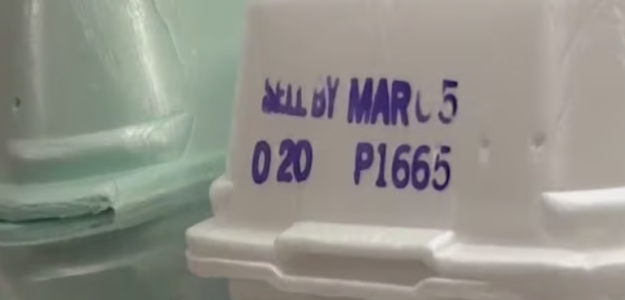Are food labels tricking you? What those dates really mean
By
Veronica E.
- Replies 0
If you’ve ever stared at a carton of milk or a box of crackers wondering whether the date stamped on it means “toss” or “still safe,” you’re not alone.
Many shoppers assume that “sell by,” “use by,” and “best by” dates are hard expiration rules—but the truth is much more complicated.
In fact, most of those labels aren’t about food safety at all, and the confusion surrounding them is costing Americans both money and good food.
Across the country, families throw away perfectly edible groceries out of caution, while food waste piles up in landfills.
Learning the difference between these labels can save you time, money, and stress—and it may even help cut down on waste in your kitchen.
Despite how it sounds, “sell by” is not a warning to consumers.
It’s a note for grocery store staff, telling them how long to keep a product on the shelf before rotating it out.
That’s why a gallon of milk or package of chicken doesn’t suddenly go bad the day after its “sell by” date.
As long as it’s been stored properly, food is often safe for days—or even weeks—after that date.
Think of it as an inventory guideline, not a safety measure.
There are more than 50 different date phrases in use, from “expires on” to “freshest before.”
Some relate to quality, others to safety, and some are simply marketing.
Here’s a quick breakdown:
With so many variations, it’s no wonder shoppers second-guess whether food is safe to eat.
This label confusion isn’t just a hassle—it’s a big contributor to waste.
The FDA estimates that about 20% of food waste in the US comes from misunderstanding date labels.
That equals nearly 60 million tons of food thrown out each year, much of it still safe to eat.
Beyond the environmental impact, it’s money out of your pocket every time a perfectly fine item gets tossed.
In 2023, California introduced a new law to simplify food labeling.
The state banned the use of “sell by” on packaged foods and now requires only clear, standardized terms like “best if used by,” “use by,” or “frozen by.”
Smaller packages can use abbreviations like “BB” or “UB,” but the idea is to cut down on shopper confusion.
Lawmakers hope that other states will adopt similar standards, making grocery shopping easier for everyone while reducing waste.
Knowing the truth behind labels is one thing—but using that knowledge is what saves money and cuts waste.
Here are a few ways to shop and store smarter:
Food labels were meant to help, but too often they end up confusing shoppers and fueling waste.
Understanding the real meaning behind “sell by,” “best by,” and “use by” dates can help you stretch your grocery dollars while cutting down on unnecessary toss-outs.
With new labeling laws starting to take shape, there’s hope for clearer communication ahead—but in the meantime, trust your senses and shop smarter.
Read next: Supermarket bread labels decoded—how to tell what’s truly fresh

Have you ever thrown away food just because the date on the package made you second-guess it? How do you decide whether something in your fridge or pantry is still good to eat?
Many shoppers assume that “sell by,” “use by,” and “best by” dates are hard expiration rules—but the truth is much more complicated.
In fact, most of those labels aren’t about food safety at all, and the confusion surrounding them is costing Americans both money and good food.
Across the country, families throw away perfectly edible groceries out of caution, while food waste piles up in landfills.
Learning the difference between these labels can save you time, money, and stress—and it may even help cut down on waste in your kitchen.
What “sell by” really means
Despite how it sounds, “sell by” is not a warning to consumers.
It’s a note for grocery store staff, telling them how long to keep a product on the shelf before rotating it out.
That’s why a gallon of milk or package of chicken doesn’t suddenly go bad the day after its “sell by” date.
As long as it’s been stored properly, food is often safe for days—or even weeks—after that date.
Think of it as an inventory guideline, not a safety measure.
Also read: 19 Genius Hacks You Can Use Right Now to Slash Your Food Waste and Save Money!
A jumble of labels adds to the confusion
There are more than 50 different date phrases in use, from “expires on” to “freshest before.”
Some relate to quality, others to safety, and some are simply marketing.
Here’s a quick breakdown:
- Sell by – For store employees, not customers.
- Best if used by / Best by – About peak quality, not safety.
- Use by – Can refer to safety for highly perishable foods, but more often about freshness.
- Freeze by – Suggests when freezing will preserve the best taste and texture.
With so many variations, it’s no wonder shoppers second-guess whether food is safe to eat.
Also read: That label said "fresh"—but what a Costco shopper found tells a different story
Food waste adds up quickly
This label confusion isn’t just a hassle—it’s a big contributor to waste.
The FDA estimates that about 20% of food waste in the US comes from misunderstanding date labels.
That equals nearly 60 million tons of food thrown out each year, much of it still safe to eat.
Beyond the environmental impact, it’s money out of your pocket every time a perfectly fine item gets tossed.
Also read: These 7 deceptive foods are secretly loaded with sugar—protect your health now!
California’s push for change
In 2023, California introduced a new law to simplify food labeling.
The state banned the use of “sell by” on packaged foods and now requires only clear, standardized terms like “best if used by,” “use by,” or “frozen by.”
Smaller packages can use abbreviations like “BB” or “UB,” but the idea is to cut down on shopper confusion.
Lawmakers hope that other states will adopt similar standards, making grocery shopping easier for everyone while reducing waste.
Also read: Walmart revamps over 2,000 stores: What’s new for your shopping experience
Smart shopping and storage tips
Knowing the truth behind labels is one thing—but using that knowledge is what saves money and cuts waste.
Here are a few ways to shop and store smarter:
- Rely on your senses – If it looks, smells, and tastes normal, it’s likely safe.
- Plan purchases – Make lists and stick to them to avoid overbuying.
- Watch portion sizes – Buy smaller quantities if you don’t go through items quickly.
- Use your freezer – Freezing is one of the easiest ways to extend shelf life.
- Check unit prices – Compare by weight or volume to find the best deals.
- Take advantage of loyalty programs – Points and discounts add up over time.
Food labels were meant to help, but too often they end up confusing shoppers and fueling waste.
Understanding the real meaning behind “sell by,” “best by,” and “use by” dates can help you stretch your grocery dollars while cutting down on unnecessary toss-outs.
With new labeling laws starting to take shape, there’s hope for clearer communication ahead—but in the meantime, trust your senses and shop smarter.
Read next: Supermarket bread labels decoded—how to tell what’s truly fresh
Key Takeaways
- “Sell by” dates are intended for grocery stores, not consumers, and do not mean food is unsafe.
- Most foods are still good past the printed date if stored properly, making many toss-outs unnecessary.
- Label confusion contributes to about 20% of US food waste—nearly 60 million tons annually.
- California has banned “sell by” labels and now requires simpler terms like “best if used by” and “use by” to reduce waste.
Have you ever thrown away food just because the date on the package made you second-guess it? How do you decide whether something in your fridge or pantry is still good to eat?







